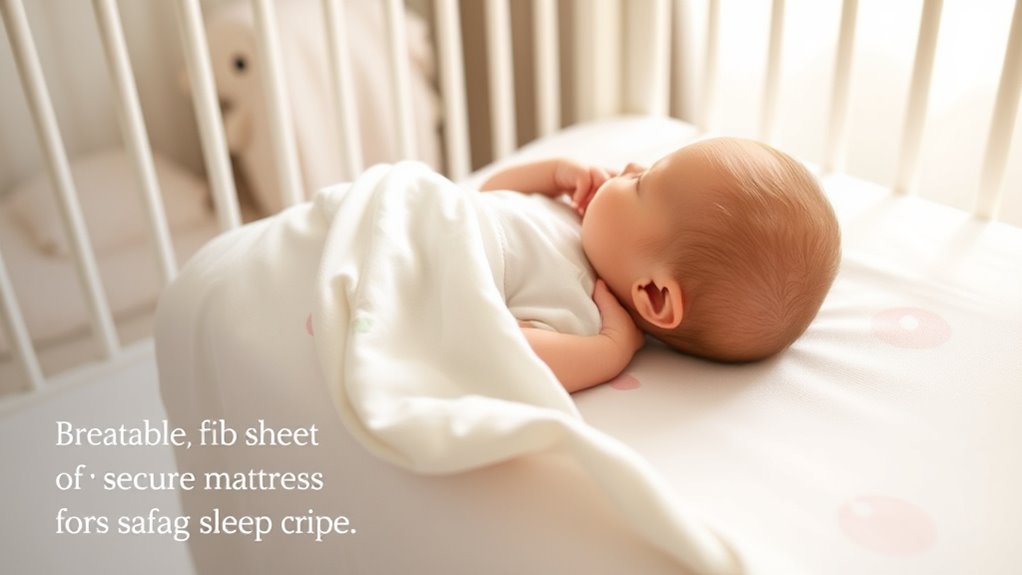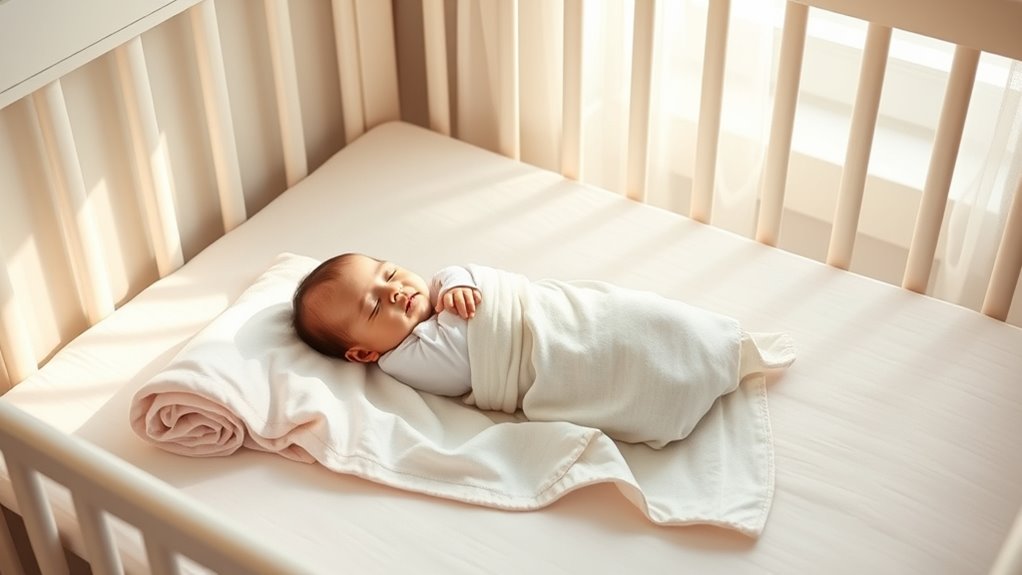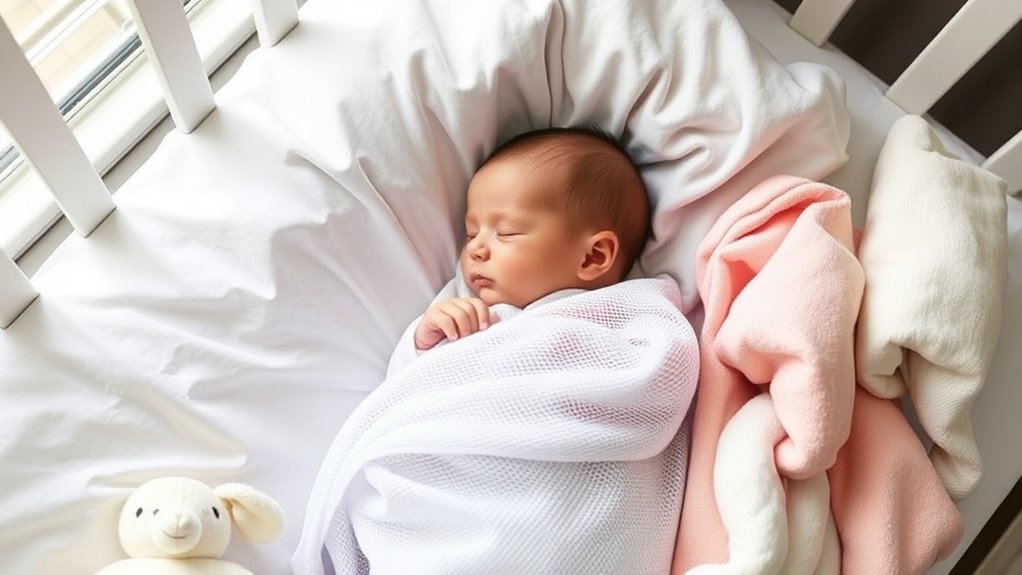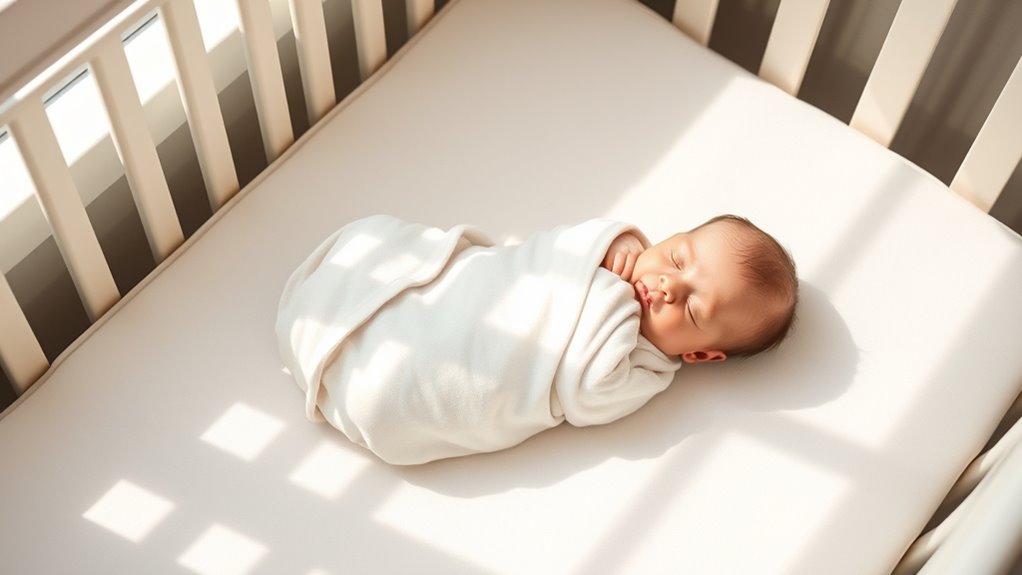To guarantee safe sleep for your newborn, always place your baby on their back on a firm, flat surface free from soft bedding, pillows, or stuffed animals. Keep the sleep environment cool, well-ventilated, and free from cords or hazards. Avoid sleeping on couches or with loose blankets, and establish a calm, consistent bedtime routine. Following these practices can greatly reduce risks like SIDS and suffocation—if you want to learn more, here’s what you need to know.
Key Takeaways
- Always place the newborn on their back for sleep to reduce SIDS risk.
- Use a firm, flat sleep surface free from soft bedding, pillows, and stuffed animals.
- Keep the baby’s head uncovered and ensure proper ventilation in the sleep area.
- Remove hazards like cords, loose blankets, and window blinds from the sleep environment.
- Maintain a consistent bedtime routine and appropriate room temperature for safe, comfortable sleep.
Recommended Sleep Positions for Newborns

To guarantee safe sleep for your newborn, it’s important to understand the recommended sleep positions. Sleep position safety is vital in reducing the risk of Sudden Infant Death Syndrome (SIDS). The best practice for newborn sleep practices is to place your baby on their back every time they sleep, whether during naps or at night. This position keeps the airway clear and minimizes the risk of suffocation. Avoid placing your newborn on their stomach or side, as these positions are associated with increased SIDS risk. Always ensure the baby’s head remains uncovered and that they are not prone to rolling into unsafe positions. Proper sleep environment also plays a crucial role in safety, ensuring the area is free from soft bedding and loose objects that could pose hazards. Following these guidelines helps promote safe sleep habits and supports your baby’s well-being. Recent advances in AI-powered monitoring are also helping parents ensure their infants sleep safely and comfortably. Additionally, providing a safe sleep environment, free from soft bedding and loose objects, further reduces potential hazards.
Creating a Safe Sleep Environment

Creating a safe sleep environment for your newborn involves more than just choosing the right sleep position. You need to consider co sleeping safety, making sure your baby sleeps on a firm surface without soft bedding, pillows, or stuffed animals that could cause suffocation. Keep the sleep area free of hazards and avoid placing the crib near cords or window blinds. When using sleep training techniques, establish a consistent bedtime routine that helps your baby associate sleep with a safe, calm environment. Guarantee the room is at a comfortable temperature to prevent overheating. Always supervise your baby closely, especially if co sleeping, to reduce risks. A well-prepared sleep space promotes safe, restful nights, supporting your newborn’s health and development. Understanding dog breeds can help you choose the safest sleeping environment if you have a dog sharing the space. Additionally, ensuring proper ventilation and airflow can help maintain a safe sleep environment by reducing the risk of carbon dioxide buildup and overheating.
How to Reduce Risks of Sleep-Related Dangers

Reducing sleep-related risks for your newborn requires careful attention to their sleep environment and habits. Start by understanding co-sleeping safety; if you choose to share a bed, ensure there are no gaps, soft bedding, or pillows that could pose suffocation hazards. Always place your baby on their back to sleep, decreasing the risk of SIDS. Implement sleep training strategies that establish a consistent bedtime routine, helping your baby learn healthy sleep habits without resorting to unsafe practices like bed-sharing. Keep the sleep area free of toys or loose blankets, which can be dangerous. Regularly check your baby’s sleep environment for hazards, and stay informed about safety guidelines. These steps promote safer sleep and help lower the risk of sleep-related dangers for your newborn. Additionally, creating a safe sleep environment can further reduce potential hazards and support your baby’s well-being. Proper use of sleep environment guidelines ensures a safer space for your infant.
Choosing the Right Sleep Surface and Bedding

Selecting a safe sleep surface and bedding is essential for your newborn’s well-being. Your goal is to create a secure environment that reduces suffocation and SIDS risks. Focus on crib safety by choosing a firm, flat sleep surface made of appropriate materials—avoid soft mattresses or plush surfaces. Keep the bedding simple to prevent suffocation hazards. Here are some tips:
- Use a fitted sheet made of breathable, easy-to-clean materials
- Avoid pillows, blankets, or stuffed animals in the crib
- Ensure the mattress fits snugly in the crib frame with no gaps
- Opt for a crib with sturdy slats and no drop sides
- Incorporate a safe sleep environment by removing any unnecessary items from the crib to minimize hazards
- Regularly check that the crib’s structural integrity remains intact to prevent any accidents
- Consider the proper ventilation in the sleep area to help regulate temperature and reduce sleep-related risks
Choosing the right sleep surface and bedding helps keep your baby safe and comfortable throughout the night.
Tips for Establishing Healthy Sleep Routines

Establishing healthy sleep routines early on can help your newborn develop consistent sleep habits and improve overall well-being. Start by creating a calming bedtime environment and sticking to a regular schedule, which signals to your baby that it’s time to sleep. Co-sleeping benefits can include easier night feedings and soothing, but guarantee safety guidelines are followed. Incorporate gentle sleep training methods, like establishing a consistent bedtime routine, so your baby learns to fall asleep independently over time. Consistency is key, so try to keep sleep and nap times regular. Avoid overstimulation before bed and provide a quiet, dark space. Additionally, understanding sleep training techniques can help you choose methods that best suit your baby’s needs. Practicing safe sleep practices is essential for reducing the risk of sleep-related hazards. Being informed about tuning modifications can also help parents recognize when their baby’s sleep environment or routines may need adjustments to promote better rest. By establishing these routines early, you lay the foundation for safe, healthy sleep habits that benefit both you and your newborn.
Frequently Asked Questions
When Should I Transition My Baby From a Crib to a Toddler Bed?
You should consider shifting your baby from a crib to a toddler bed when they start climbing out or become too tall for the crib. Typically, this is around age 2 or when they show signs of readiness. The right changeover timing ensures safety and comfort. Make sure your toddler bed has guardrails and is placed securely. This helps your child feel secure and encourages independence during sleep.
Are There Specific Clothing Guidelines for Safe Sleep?
You should choose sleepwear that promotes sleepwear safety by avoiding loose or bulky clothes, which can pose a suffocation risk. Opt for snug-fitting pajamas made from breathable fabrics like cotton or cotton blends to keep your baby comfortable and reduce overheating. Always check for any loose threads or decorations, and avoid wearing hats or extra blankets in the crib. Proper clothing helps create a safe sleep environment for your little one.
How Can I Tell if My Baby Is Overheating During Sleep?
You can tell if your baby is overheating during sleep by checking for signs like damp hair, flushed cheeks, or sweating, which indicate poor temperature regulation. Feel their neck or back to gauge if they’re too hot; they should feel warm but not hot or sweaty. Ensuring proper sleep comfort involves maintaining a comfortable room temperature and dressing your baby appropriately, so they stay cozy without overheating.
Is It Safe to Use Sleep Positioners or Wedges?
Using sleep positioners or wedges isn’t safe, as safety concerns have been linked to suffocation and sudden infant death syndrome (SIDS). You should avoid these devices because they can shift or cause your baby to become wedged, increasing risk. Instead, place your baby on a firm, flat sleep surface without soft bedding or toys, ensuring a safe sleep environment that promotes healthy, safe sleep habits.
What Are the Signs of Sleep Environment Hazards?
You should look for signs of sleep environment hazards, like loose bedding, pillows, or stuffed animals that could cause suffocation. Check for hazards such as gaps between the mattress and crib sides, prone sleeping surfaces, or cords within reach. Regular hazard identification helps make sure your baby’s sleep environment remains safe. Keep the sleep area clutter-free and always follow safe sleep guidelines to reduce the risk of sleep environment hazards.
Conclusion
By following these gentle guidelines, you create a cozy haven where your little one can rest peacefully. Think of it as laying the foundation for sweet dreams and bright mornings ahead. When you prioritize safe sleep practices, you nurture not just your baby’s well-being but also your own peace of mind. Remember, each careful step you take helps guarantee your precious one’s journey to restful nights is as smooth and comforting as a lullaby.









